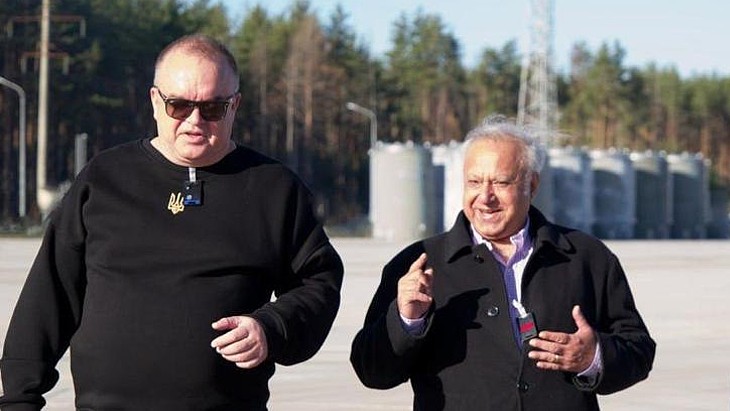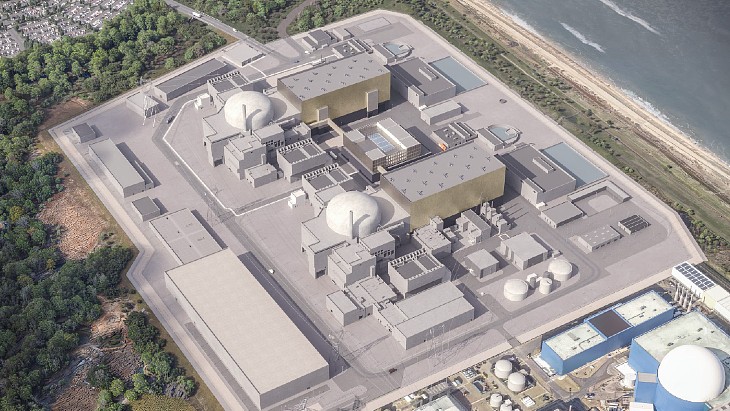Construction and commissioning of the facility continued despite the on-going war with Russia, which included Russian forces controlling the Chernobyl nuclear site for more than a month in February and March 2022.
Energoatom said that the new facility will save USD200 million a year which it previously had to pay for the used fuel to be transported and stored in Russia. It will also avoid the risk of having to interrupt operation of plants because of a lack of capacity to safely store used fuel.
The CSFSF, located in the Chernobyl Exclusion Zone, is a dry storage site for used nuclear fuel assemblies from the country's VVER-1000 and VVER-440 reactors. It is designed to have a total storage capacity of 16,530 used fuel assemblies, including 12,010 VVER-1000 assemblies and 4520 VVER-440 assemblies. Contracts were signed for its construction with USA-based Holtec International in 2005, though construction only began in 2017.
Energoatom President Petro Kotin said, during a visit to the CSFSF: "The safe, reliable and secure operation of the storage facility is critically important for ensuring the uninterrupted supply of electricity to our citizens... [and] also achieves one of the most important goals in strengthening the energy independence of our country. At the same time, cost savings for the removal and dry storage of spent nuclear fuel from domestic nuclear power plants this year alone have already fully covered the costs of the construction."
Holtec President and CEO Kris Singh said: "Approximately two decades ago, Ukraine began its long quest to establish a supremely safe consolidated interim storage facility to take full control of its used nuclear fuel. That journey has finally come to fruition ... the successful transport and storage of spent nuclear fuel by Energoatom from its operating nuclear reactors to the Central Spent Fuel Storage Facility is a fitting symbol of Ukraine’s resolve to achieve complete operational independence in regard to management of its spent fuel discharged by the country’s fleet of reactors and provide a safe and economic solution for long-term management of used nuclear fuel at its domestic centralised storage facility. This facility now has made Ukraine an international leader in consolidated storage of spent nuclear fuel."
He said Holtec's "high-capacity Double Wall Multi-Purpose Canisters and the world’s most thermally efficient transport cask HI-STAR 190 will become Ukraine’s workhorse to transport the country’s used fuel from its nine reactors to the nation’s consolidated interim storage facility". Although the design life of the new facility is 100 years he said he expected it "to be many times longer".
Most of the equipment for the centre was manufactured at Holtec facilities in the USA, although contractors in Estonia, Italy, Germany and the Netherlands were also involved. Energoatom and Holtec have plans to create a joint venture enterprise to develop a manufacturing and technology centre in Ukraine to localise production of equipment for the storage and transportation of used nuclear fuel and also for equipment for Holtec's small modular reactor.
Kotin said: "Ukraine always strives to demonstrate its innovative leadership in the field of clean energy with the help of advanced technologies, to take concrete steps in the direction of energy independence and diversification, to ensure reliable energy supply for its citizens. We must use advanced and absolutely safe nuclear technology, as our nuclear power generates more than 55% of the country's electricity. This joint cooperation with Holtec provides Ukraine with an excellent opportunity to become a leader in the field of global nuclear energy."
Ukraine currently has nine operating reactors at South Ukraine, Khmelnitsky and Rivne nuclear power plants. A further six units at Zaporizhzhia nuclear power plant have been under Russian military control since early March 2022.





_55530.jpg)
_42372.jpg)
_37521_70699.jpg)

_76087_55556.jpg)




